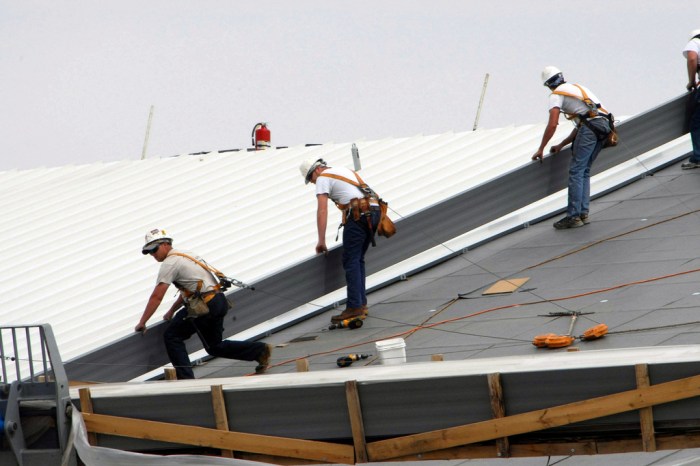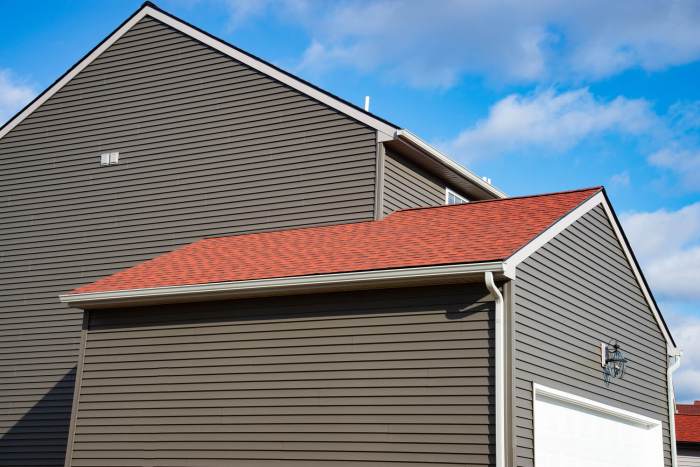Commercial Roofers: How They Serve Large-Scale Projects
Embarking on the journey of Commercial Roofers: How They Serve Large-Scale Projects, readers are invited into a world where expertise meets innovation in the realm of large-scale roofing projects. As we delve deeper into the intricacies of this specialized field, a tapestry of knowledge unfolds, revealing the crucial role that commercial roofers play in shaping the skyline of our modern cities.
Exploring the nuances of material selection, project planning, and execution, this narrative promises to shed light on the dynamic and challenging landscape that commercial roofers navigate with finesse and precision.
Overview of Commercial Roofers in Large-Scale Projects
Commercial roofers play a crucial role in large-scale projects, providing expertise in installing, repairing, and maintaining roofs for commercial buildings. These professionals are specially trained to handle the unique challenges that come with large-scale roofing projects, ensuring the safety and longevity of the structure.
Importance of Hiring Specialized Commercial Roofers
- Specialized knowledge: Commercial roofers have specific training and experience in working on commercial roofs, which are typically larger and more complex than residential roofs.
- Compliance with regulations: Commercial buildings have strict regulations and codes that must be followed when it comes to roofing. Specialized roofers are well-versed in these requirements.
- Quality workmanship: Large-scale projects require precise and high-quality work to ensure the durability and integrity of the roof. Commercial roofers have the skills and tools necessary to deliver exceptional results.
- Efficiency and timeliness: Experienced commercial roofers can efficiently complete projects within the set timeframe, minimizing disruptions to the business operations.
Typical Scope of Work in Large-Scale Roofing Projects
- Roof inspection and assessment: Commercial roofers start by evaluating the existing roof to determine the extent of repairs or replacements needed.
- Roof installation or replacement: The roofers will then proceed with installing a new roof or replacing the existing one, ensuring proper insulation and drainage.
- Maintenance and repairs: Regular maintenance and timely repairs are essential to prolong the lifespan of the roof and prevent costly damage.
- Emergency services: Commercial roofers are also equipped to handle emergency situations such as leaks or storm damage, providing prompt assistance to minimize further issues.
Expertise and Skills Required
Commercial roofers working on large-scale projects require a specific set of expertise and skills to ensure the successful completion of complex roofing systems safely and efficiently.
Specific Expertise and Skills
Commercial roofers for large-scale projects need to have a deep understanding of various roofing materials, installation techniques, and project management. They should be skilled in identifying structural issues, repairing leaks, and implementing preventive maintenance measures to prolong the lifespan of the roof.
- Knowledge of different roofing materials such as EPDM, TPO, PVC, metal, and asphalt
- Expertise in roof system design and installation
- Ability to work with specialized tools and equipment
- Project management skills to coordinate with other contractors and meet deadlines
Safety Measures and Certifications
Safety is paramount in large-scale roofing projects, and commercial roofers must adhere to strict safety protocols to prevent accidents and injuries. They also need to obtain relevant certifications to demonstrate their proficiency and commitment to safety standards.
- OSHA certification for working at heights
- Training in fall protection and hazard communication
- Knowledge of fire safety regulations and protocols
- Regular safety inspections and risk assessments
Handling Complex Roof Designs and Materials
Large-scale projects often involve intricate roof designs and a variety of materials that require specialized skills and expertise to install and maintain. Commercial roofers must be able to adapt to different challenges and provide innovative solutions to address complex roofing systems effectively.
- Experience in working with curved or sloped roofs
- Knowledge of green roofing technologies and sustainable materials
- Expertise in handling custom-designed roofs and unique architectural features
- Ability to troubleshoot and repair complex roofing systems efficiently
Project Planning and Execution
When it comes to large-scale roofing projects, meticulous planning and efficient execution are essential for success. Commercial roofers follow a structured process from the beginning to ensure timely completion while coordinating with various stakeholders.
Planning a Large-Scale Roofing Project
- Initial Assessment: Commercial roofers start by conducting a thorough assessment of the project site to understand its unique requirements and challenges.
- Design and Budgeting: Once the assessment is complete, roofers work on creating a detailed design plan and budget that align with the client's needs and specifications.
- Permitting and Compliance: Obtaining necessary permits and ensuring compliance with building codes and regulations are crucial steps in the planning phase.
Strategies for Timely Completion
- Setting Realistic Deadlines: Commercial roofers establish realistic timelines for each phase of the project to ensure smooth progress.
- Efficient Resource Management: Proper allocation of resources, including materials and manpower, is vital to avoid delays.
- Regular Monitoring and Communication: Constant monitoring of the project's progress and open communication with the client help in identifying and addressing any issues promptly.
Coordination with Other Contractors and Stakeholders
- Collaborative Approach: Commercial roofers work closely with other contractors involved in the project, such as electricians or HVAC specialists, to streamline workflow and prevent conflicts.
- Stakeholder Engagement: Effective communication with stakeholders, including clients, architects, and project managers, ensures everyone is on the same page regarding project goals and timelines.
- Problem-Solving: In case of any unexpected challenges during the project, commercial roofers collaborate with stakeholders to find efficient solutions without compromising quality.
Material Selection and Installation Techniques

When it comes to large-scale commercial roofing projects, the selection of materials and installation techniques plays a crucial role in the overall success and durability of the roof. Proper material selection and installation are essential for ensuring the longevity and performance of the roof.
Types of Roofing Materials
There are several types of roofing materials commonly used in large-scale commercial projects, each with its own unique characteristics and benefits:
- Single-Ply Membrane: Lightweight and cost-effective, single-ply membranes such as TPO and PVC are popular choices for large commercial roofs.
- Metal Roofing: Durable and long-lasting, metal roofing is known for its resistance to extreme weather conditions and low maintenance requirements.
- Built-Up Roofing (BUR): Made up of multiple layers of bitumen and reinforcing fabrics, BUR provides excellent waterproofing and insulation.
- Modified Bitumen: This type of roofing material offers enhanced flexibility and strength, making it a good option for roofs with high foot traffic.
Installation Techniques
The installation techniques for different types of roofing materials vary based on their unique properties and requirements:
- Single-Ply Membrane: Installation of single-ply membranes typically involves fully adhering the membrane to the roof substrate or mechanically attaching it.
- Metal Roofing: Metal roofing panels are usually fastened to the roof deck using screws or clips, allowing for thermal movement.
- Built-Up Roofing (BUR): BUR installation includes heating and melting the bitumen layers to create a seamless and watertight roof surface.
- Modified Bitumen: The installation of modified bitumen roofing involves torching or cold adhesive application to secure the material to the roof.
Quality Control and Inspections
Quality control and inspections are essential during the installation process to ensure that the roof is installed correctly and meets industry standards:
- Regular inspections help identify any installation errors or potential issues that could compromise the roof's performance.
- Quality control measures, such as verifying material integrity and proper installation techniques, are crucial for the long-term durability of the roof.
Ultimate Conclusion

In conclusion, the realm of Commercial Roofers: How They Serve Large-Scale Projects is a fascinating blend of artistry and technical prowess, where each project becomes a testament to the dedication and skill of these specialized professionals. As we reflect on the diverse facets of this field, one thing remains clear - the impact of commercial roofers extends far beyond the rooftops they meticulously craft, shaping the very fabric of our urban environment.
Answers to Common Questions
What safety measures are required for commercial roofers working on large-scale projects?
Safety measures include proper training, adherence to OSHA regulations, and the use of personal protective equipment.
How do commercial roofers handle complex roof designs in large-scale projects?
Commercial roofers utilize their expertise in advanced techniques and technologies to navigate complex roof designs effectively.
What types of roofing materials are commonly used in large-scale projects?
Common roofing materials include asphalt shingles, metal roofing, and TPO membranes.



